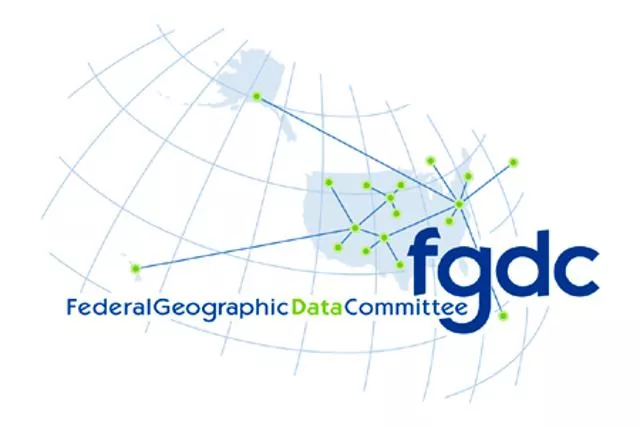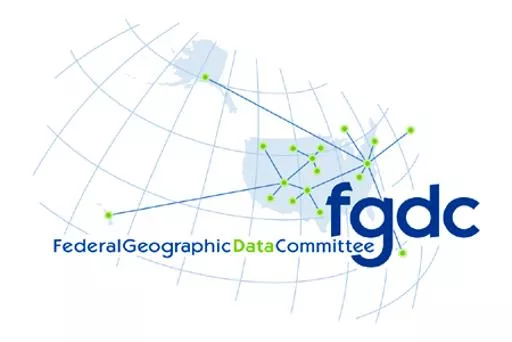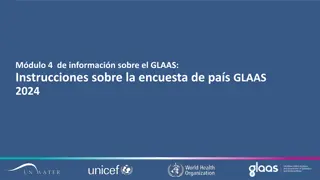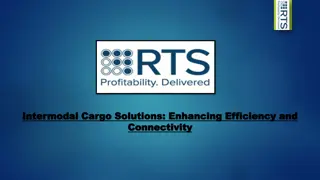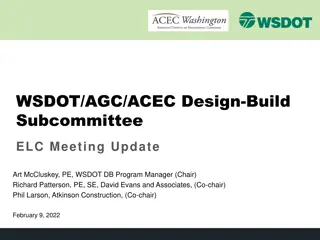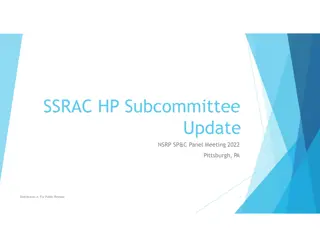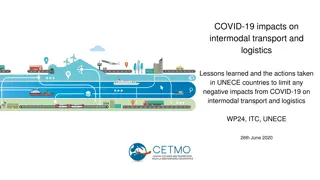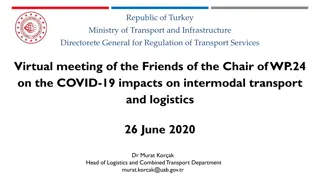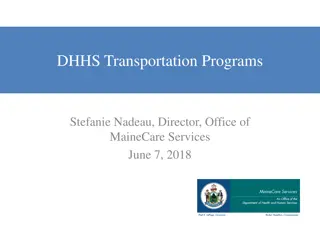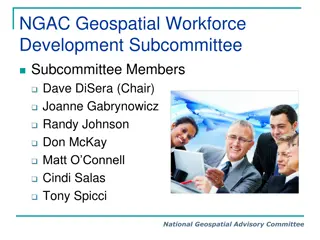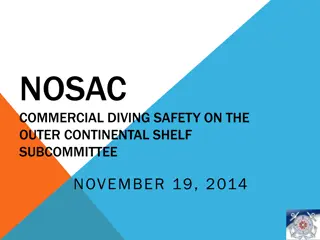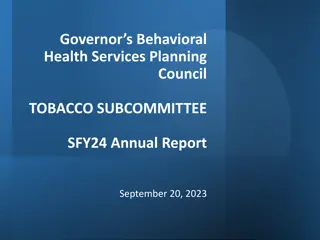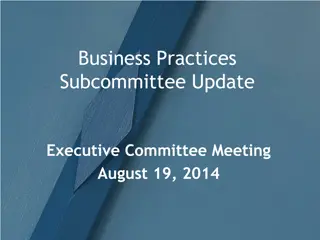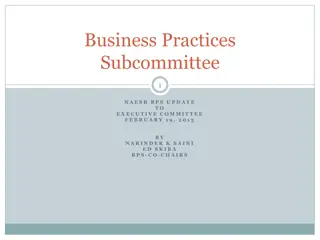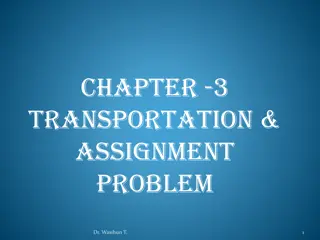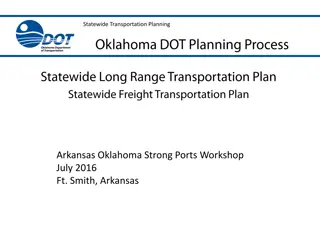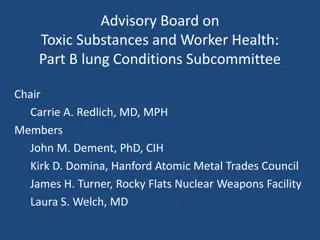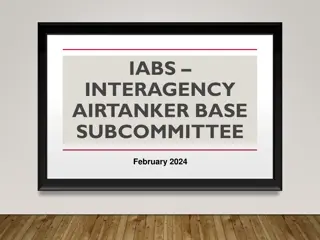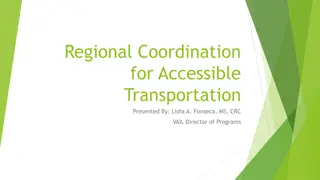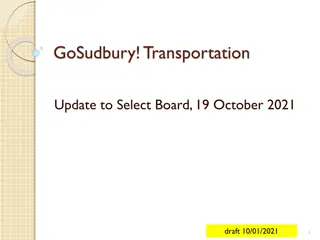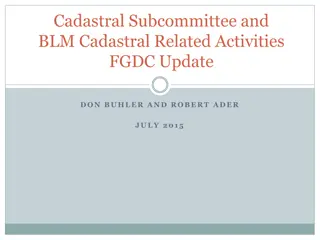Intermodal Survey Update - Coordination Group Meeting Transportation Subcommittee
This update highlights the progress of the Transportation Subcommittee's Intermodal Survey, focusing on objectives like identifying technical requirements, database standardization, and user community commonalities. The timeline of action items and survey methodology are also outlined. Key members include Mark Bradford and Raquel Hunt from the U.S. DOT.
Uploaded on Sep 18, 2024 | 0 Views
Download Presentation

Please find below an Image/Link to download the presentation.
The content on the website is provided AS IS for your information and personal use only. It may not be sold, licensed, or shared on other websites without obtaining consent from the author. Download presentation by click this link. If you encounter any issues during the download, it is possible that the publisher has removed the file from their server.
E N D
Presentation Transcript
April 9th, 2012 Coordination Group Meeting Transportation Subcommittee Update to Coordination Group Status Update of the Intermodal Survey Mark Bradford Raquel Hunt Spatial Data Analyst\U.S. DOT Chair 202.366.6810 Mark.Bradford@dot.gov GIS Program Manager\U.S. DOT Co-Chair 202.493.6415 Raquel.Hunt@dot.gov Date v1
Introduction Transportation Subcommittee was reinstated October 2010 Work Plan on Intermodal was approved by FGDC December 2011 Members include: Mark Bradford, U.S. DOT Raquel Hunt, U.S. DOT Dick Vraga, USGS Lynda Liptrap, Census 2
Intermodal Business Plan Identify and standardize an intermodal facility database that can serve as a geographic foundation for all organizations dealing with modes of transportation. This includes passenger and non-passenger activities. The goal is to design the database in a way that will allow it to be adaptable 3
Intermodal Survey Identify the technical requirements for a spatial database Identify the multiple business operations Defined to accommodate the multiple users and not to be built to a specific set of business needs. 4
Current Intermodal Database Used the current US DOT Intermodal Database as a starting point to help define the technical requirements for a new intermodal database. The existing database was designed to support the Commodity Flow Survey The survey listed the Intermodal database definitions and data dictionaries for agreement or provide the modifications 5
Timeline of Action Items Presented the Work Plan to FGDC June 2012 Presented the Work Plan at ESRI UC July 2012 Survey sent out Sept 2012 Final Result return in Dec 2012 Tally results Jan/Feb 2013 Present results to FGDC April 2013 6
Survey Objectives To assess its existing data resources and lay the groundwork for future efforts Explore an intermodal framework that can be used by both the public and private sectors Determine the commonalities of the data by the user community 7
Methodology The survey was not intended to be a scientific survey It was designed to lay the foundation for future investigation, data development, and interagency coordination. Each TSC member was assigned a government agency and/or discipline to survey. 8
Survey Objectives General Determining the type of user and their need for Intermodal Specific Changes to the existing database Spatial Accuracy Connections Mandatory Attributes Next Steps Other Sources of Intermodal data Other users of Intermodal data Current Intermodal Database Review of every attribute to determine: Required, Desired, or Needed 9
Results - General GIS users Have need for Intermodal database Use in routing Passenger information valuable Have regulations that apply to freight or passenger movement 10
Results - Specific Agree with definitions used in Intermodal database Represented as a point 1:24,000 scale Model with Multiple modes Other useful attributes weight, percentage of freight activity, average transfer time, number of passengers Other identified issues Support current models One data source Used for risk reduction/planning and policy 11
Results Next Steps Contact other users of intermodal data (VOLPE, Local Agencies ) Other sources of data Official Railway Guide, Amtrak, Federal Lands, FHWA s Freight Analysis Framework Other useful information AADT, feature level metadata, maintain multiple database identifiers for external systems 12
Conclusion Standardization of terminology A single, expandable database; configurable depending on users needs Facilities and mode networks Because of resource shortages cannot pursue enhancement of the current intermodal data 13
Next Steps Support TFTN efforts Support mode specific data efforts in the NSDI Promote/expand DOTs participation in data.gov to Geo.Data.gov Publishing and hosting transportation specific WFS 14
Questions? Mark Bradford, U.S. DOT 202.366.6810 Mark.Bradford@dot.gov Mark.Bradford@dot.gov Raquel Hunt, U.D. DOT 202.493.6415 Raquel.Hunt@dot.gov Raquel.Hunt@dot.gov 15

 undefined
undefined
